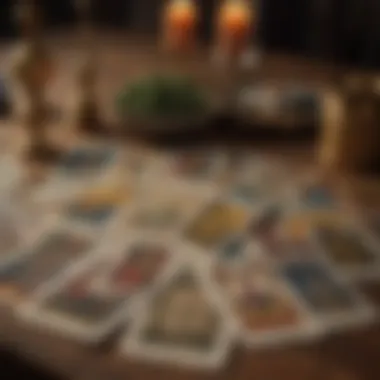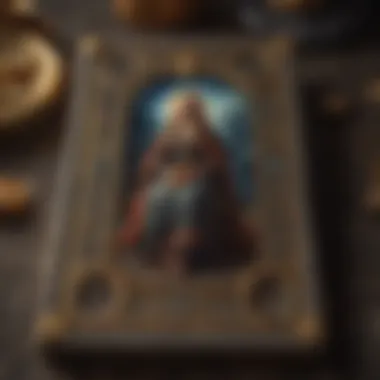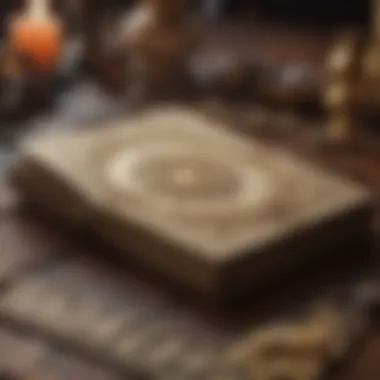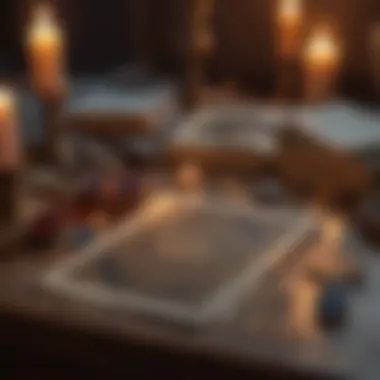Mastering Tarot Reading: A Free Guide for All Levels


Intro
Exploring tarot is an enriching experience filled with mystery and introspection. Reading tarot cards can provide personal insights that guide one’s journey, but many people hesitate to start due to perceived costs. The beauty of tarot is that you can learn it entirely for free. This guide aims to reveal resources and techniques that make tarot reading accessible to anyone interested. By the end of this article, you will have enough knowledge and tools to begin your tarot journey without spending a penny.
Understanding Tarot Cards
Before diving into readings, it is crucial to understand what tarot is. Tarot cards are typically used as a divination tool, offering insights into one’s life and decisions. A standard tarot deck consists of 78 cards, divided into the Major and Minor Arcana. The Major Arcana carries significant life themes, while the Minor Arcana focuses on daily events. Each card possesses its unique symbolism and meanings.
The Importance of Symbolism
Symbolism is paramount in tarot reading. Each card's imagery plays a significant role in interpreting its message. For instance, the Death card does not signify physical death but rather transformation and change. Understanding these symbols is vital for effective tarot interpretation.
Free Resources for Learning Tarot
To learn tarot without spending money, numerous resources are available online. Here are some essential tools.
- Websites: Numerous websites offer free tarot guides, such as Biddy Tarot or Labyrinthos. These platforms provide explanations for card meanings and sample spreads.
- YouTube Channels: Several YouTubers create comprehensive tutorials on tarot. They cover subjects like card meanings, spreads, and simple readings.
- Online Communities: Joining groups on platforms like Reddit or Facebook can connect you with other tarot enthusiasts who may share their expertise and answer queries.
Practical Tips for Using Resources
- Start with a free online course to establish a foundation.
- Utilize mobile apps for daily card readings and randomized draws.
- Engage with online forums to ask questions and discuss interpretations.
Learning tarot is not just about memorizing card meanings but understanding how they relate to your life and experiences.
Developing Your Personal Style
Tarot reading is a personal journey. Each person develops their style, making the readings unique. Here is how you can foster your individual approach:
- Practice Regularly: The more you practice, the more fluent you become in your interpretations. Daily pulls can enhance your skills.
- Keep a Journal: Document your readings and thoughts. This reflection solidifies learning and helps identify patterns over time.
- Trust Your Intuition: Your first impression of a card often holds meaningful insights. Allow your intuition to guide your interpretations.
Ending
Learning tarot cards for free is entirely achievable with the right resources and dedication. Start your journey by exploring the basics, utilizing available tools, and developing your unique style. Embrace the mystery of tarot and allow it to illuminate your path.
Prologue to Tarot Reading
The art of Tarot reading serves as a profound and intricate practice that provides insights into one’s life and mind. It is not merely about predicting the future but involves deep self-reflection and understanding. In this section, we will explore the significance of Tarot in both historical and modern contexts. Each aspect will shed light on how Tarot cards can be instrumental in personal development.
The Nature of Tarot
Tarot is fundamentally a tool for guidance. It comprises a deck of cards that are rich in symbolism and meaning. The cards can evoke personal interpretations and reflections, leading to revelations about one’s inner state and circumstances.
The nature of Tarot also involves intuition. As you learn to read the cards, you will find that your personal feelings and thoughts start to weave into the interpretation process. This is vital because Tarot reading becomes more meaningful when it resonates personally with the reader.
Tarot can be viewed as a mirror, reflecting back the hidden aspects of our psyche. It offers a structure to explore thoughts and feelings that might be difficult to articulate. Reading Tarot encourages self-discovery, facilitating a deeper understanding of one’s motivations, fears, and desires.


A Brief History of Tarot
The history of Tarot is as complex as the interpretations it offers. Tarot likely originated in the 15th century in Europe. Initially, it was played as a card game called tarocchi, not intended for divination. Its evolution into a tool for fortune telling started around the 18th century when esoteric societies began to adopt it for spiritual exploration.
By the late 19th century, Tarot gained prominence among occult practitioners. The cards started to take on a more mystical significance. Notable figures, including A.E. Waite and Aleister Crowley, further shaped the modern Tarot interpretation with their unique decks and ways of reading.
Today, around the world, Tarot has transcended its origins. It finds relevance in various spiritual and psychological practices. Whether you approach Tarot from a mystical or practical angle, understanding its history can enhance your reading experience.
Understanding Tarot Cards
Understanding Tarot Cards is a fundamental skill for anyone interested in the practice of tarot reading. To unlock the potential of this ancient practice, it is essential to grasp the structure and meaning behind the cards. This section will dissect the components of a tarot deck and the intricate symbolism imbued in each card. Whether you are a beginner or someone with a bit of experience, understanding these elements will provide a strong foundation as you explore tarot’s deeper insights.
Components of a Tarot Deck
A tarot deck is commonly categorized into two main parts: the Major Arcana and Minor Arcana. Each of these components serves a distinct purpose and contributes to the overall narrative that tarot cards provide.
Major Arcana
The Major Arcana consists of 22 cards. Each card represents significant life events, spiritual lessons, and overarching archetypes. A key characteristic of the Major Arcana is its rich symbolism, which often highlights profound themes in one's journey. This makes it a beneficial focus when starting out in tarot.
Unique features of the Major Arcana include its sequential order, illustrating a hero's journey, often referred to as the Fool's Journey. This offers users not only a deeper understanding of themselves but also fosters personal growth. One disadvantage may be that beginners can feel overwhelmed by the complexity and the profound nature of these cards. However, learning to connect themes within the Major Arcana provides valuable insights into personal transformation.
Minor Arcana
The Minor Arcana consists of 56 cards, divided into four suits: Cups, Pentacles, Swords, and Wands. These cards focus more on day-to-day experiences and challenges, reflecting the more mundane aspects of life. A notable characteristic of the Minor Arcana is that it allows readers to tap into immediate situations and emotions, providing a more nuanced reading.
The distinct suits each have their themes; for example, Cups are related to emotions, while Swords focus on intellect and conflict. This diversity can be particularly advantageous for understanding the variety of forces at play in everyday scenarios. That said, the sheer volume of the Minor Arcana's cards can sometimes pose a challenge for beginners, making it harder to grasp their interconnected meanings without thorough study.
The Symbolism Behind the Cards
Every tarot card is rich with symbolism, offering layers of insight that can be unraveled over time. The imagery, colors, and numbers hold significant meaning, shaping the interpretation of each card during a reading. Understanding these elements enhances the effectiveness of readings, allowing practitioners to draw on intuitive interpretations supported by the cards themselves. Each card can lead to diverse interpretations based on context, making it an ever-evolving art form.
As you continue your tarot journey, being mindful of the intricate symbolism in each card will enrich your readings and provide more profound insights into life's many mysteries.
Finding Free Resources for Learning
Finding effective and free resources is crucial for those who embark on the journey of tarot reading. Without financial investment, individuals can still access high-quality materials that enhance their understanding and skills in this ancient practice. Free resources can range from online courses to community discussions, each offering unique benefits. These tools and platforms foster an enriching learning environment, allowing both beginners and seasoned practitioners to explore, discuss, and refine their insights into tarot.
Online Platforms and Courses
Various online platforms provide free courses on tarot reading. Websites such as Coursera and Udemy often have free introductory classes. In addition, YouTube offers a plethora of video tutorials that cater to different levels of expertise. This format allows you to absorb information quickly and visually, which can enhance learning. It’s also useful for seeing practical demonstrations.
Another increasingly popular resource is social media platforms, like Instagram and TikTok. Many tarot readers share their knowledge through short clips and live sessions. This can be an engaging way to get insights, as you can directly interact with the instructors.
Books and E-books Available for Free
Books remain a timeless source of knowledge. Many authors have made their tarot guides available for free in digital format. Websites like Project Gutenberg and Open Library host a variety of free e-books on tarot. These texts often include detailed descriptions of card meanings, spreads, and interpretations, offering a comprehensive view of the field. Additionally, many public libraries offer e-book lending services where readers can access current works by prominent tarot authors at no cost.


Community Forums and Discussion Groups
Engaging with a community can dramatically enhance your tarot learning experience. Platforms such as Reddit and Facebook host numerous groups dedicated to tarot reading. These forums allow members to share their experiences, ask questions, and offer insights. Participating in discussions can deepen understanding and expose you to different perspectives on card interpretation.
Basic Tarot Reading Techniques
Understanding basic tarot reading techniques is essential for anyone looking to interpret tarot cards effectively. These techniques provide a systematic approach to reading, enabling you to glean insights and messages. The right techniques can enhance your confidence, facilitate deeper understanding, and ultimately make your tarot journey more rewarding.
Choosing the Right Spread
Selecting the right tarot spread is crucial. Different spreads serve distinct purposes. They can aid in addressing specific questions or exploring broader themes in your life. Your choice of spread can significantly affect the reading's outcome and your clarity of insights.
Three-Card Spread
The Three-Card Spread is one of the most straightforward and popular tarot spreads, especially for beginners. This method allows for a concise overview, addressing three specific aspects:
- Past – what has influenced the current situation
- Present – the immediate situation and current energy
- Future – potential outcomes based on current paths
One of the key characteristics of the Three-Card Spread is its simplicity. This spread is beneficial because it provides clear insights without overwhelming the reader. It encourages focusing on the key elements of a situation, making it particularly suitable for those new to tarot. However, it can be somewhat limited in depth compared to more complex spreads. It is excellent for quick readings but might not cover all facets of more intricate issues.
Celtic Cross Spread
The Celtic Cross Spread is another widely used method, especially for exploring a more comprehensive overview. This spread typically consists of ten cards, each representing different influences and outcomes regarding a single question or situation. The positions include aspects like the present situation, challenges, subconscious influences, and future influences.
This spread is favored for its depth. It allows the reader to dive into multiple dimensions of a single question, providing extensive insights. However, the Celtic Cross can be quite intricate and may feel overwhelming for beginners. Understanding its layout and meanings takes more practice, but it can yield profound insights in the hands of someone who has honed their skills.
Shuffling and Drawing Cards
Shuffling is more than a physical act; it establishes an energetic connection with the cards. This process allows for the dispersal of energy among the cards, preparing them for the reading. Taking your time while shuffling can create a meditative space that enhances intuition. Drawing cards can be a straightforward process or more ritualistic, depending on personal preference. Choosing the right moment and state of mind when drawing cards can impact the reading's clarity and accuracy.
Interpreting Card Meanings
Interpreting card meanings is a fundamental aspect of tarot reading. Each card carries inherent meanings and symbolism that can change based on its position in a spread. Readers should develop skills in recognizing not just the standard meanings but also how a card resonates with them personally. A card might remind someone of a specific life event or person, enriching the interpretation. The key is to balance intuition with established meanings, fostering a more personalized and relevant reading experience.
Developing Personal Intuition
Developing personal intuition is an essential part of learning tarot. Intuition allows you to connect deeper with the cards, leading to more meaningful interpretations. When you rely on intuition, the readings become more personal and relevant. This section explores the benefits of nurturing intuition and offers practical ways to enhance this skill.
Meditation and Mindfulness Practices
Meditation and mindfulness are powerful tools for enhancing intuition. When you meditate, you calm your mind. This clarity helps you focus on your feelings and thoughts during a tarot reading. Simple practices, like deep breathing or visualizing light surrounding you, can greatly impact your intuition.
- Find a Quiet Space: Choose a place that feels comfortable. Close your eyes, and focus on your breathing.
- Set an Intention: Before starting, intend to connect with your intuitive self.
- Visualize: Imagine yourself surrounded by light. This can help you protect your energy.
- Mindfulness: Throughout the day, practice being present. Observe your feelings and reactions to various situations.
These techniques can be adapted to daily routines. Regular practice fosters a clearer channel to your intuitive insight, which can significantly improve tarot readings.


Keeping a Tarot Journal
A tarot journal provides a structured way to track your thoughts and progress. This practice allows you to document your readings, feelings, and any insights you gain. You can revisit entries later, aiding in understanding patterns and personal evolution over time.
- Document each Reading: Note down the spread, card positions, and interpretations. Over time, you will see how different cards resonate with your life.
- Reflect on Feelings: Record your feelings before and after readings. This helps you notice how your intuition responds.
- Review Regularly: Periodically read past entries. You may find themes or evolvement in your tarot reading skills.
Having a tarot journal is essential for developing intuition. It provides feedback loops and encourages growth in understanding both the cards and your personal insights.
Common Misconceptions about Tarot
Understanding the common misconceptions associated with tarot is vital for anyone venturing into this ancient practice. Many individuals harbor mistaken beliefs that can hinder their understanding and appreciation of tarot reading. Clarity in this area not only demystifies the practice but also enhances a reader's ability to receive insight from the cards. Recognizing what tarot is, and is not, fosters a healthier relationship with it.
Debunking Myths about Fortune Telling
One of the primary misconceptions about tarot is that it is solely a tool for fortune telling. Many people presume that tarot cards predict the future with absolute certainty. This belief can lead to unrealistic expectations and a superficial understanding of tarot. In reality, tarot serves as a reflective tool, providing insights that assist individuals in making informed decisions.
- Fortune telling implies that the future is a fixed road. However, tarot encourages a more dynamic view of possibilities. The cards act as mirrors, reflecting one's current situation and choices. By interpreting the cards, users can see paths they may not have considered.
- The cards do not dictate fate but present options. Each tarot reading is subjective. The interpretation of the cards varies greatly depending on the context and the reader's intuition.
This understanding is important for ensuring that users do not rely solely on tarot as a predictive framework. Instead, they should view it as a means to gain clarity in their lives.
Understanding Tarot as a Tool for Insight
Tarot acts as a potent tool for self-reflection and personal insight. It is not merely about revealing future events but rather about deepening one's understanding of their surroundings. Tarot cards encourage introspection, illuminating underlying thoughts and emotions.
Tarot readings can help individuals assess their emotions, relationships, and life choices. Through the imagery and symbolism of the cards, readers can gain awareness of their mental blocks and behavioral patterns.
- Insights gained from tarot can lead to increased personal clarity. They can highlight areas in life needing attention or change.
- Tarot does not offer black-and-white answers. Instead, it provides a framework to understand complex situations and guides users towards their own conclusions.
As people engage with tarot, they often find that it grows more significant over time. The more one practices and reflects, the deeper the insights become. This transformative nature of tarot is a critical aspect to embrace.
“Tarot is not about predicting the future. It is about understanding your present.”
In summary, addressing misconceptions about tarot enriches its practice. By understanding that it is not just about fortune telling and recognizing its role in fostering insight, users can engage with tarot in a more profound way.
Closure
Understanding the conclusion of this article is essential. It summarizes the journey through tarot reading while emphasizing continuous exploration and learning. Ultimately, tarot is not just about the cards; it encompasses intuition, personal growth, and self-reflection.
Reflecting on Your Learning Journey
Taking a moment to reflect on your learning journey with tarot reading can provide great insight. Every reader has a unique path, molded by experiences, beliefs, and the insights garnered along the way. It is essential to acknowledge your progress, regardless of how small it may seem.
- Assess the initial expectations you had when you began learning tarot.
- Consider how your interpretations of cards have grown over time.
- Take note of the resources that have significantly contributed to your understanding.
Self-reflection serves as a powerful tool, helping you identify strengths and areas that still need work. By keeping a Tarot journal, you can document these reflections. This practice not only tracks your growth but also strengthens your connection with the cards.
Next Steps in Tarot Reading
As you conclude your introductory phase into tarot reading, consider what comes next. The next steps lay the foundation for deeper understanding and practice. Here are various paths you might explore:
- Practice Regularly: Consistency is crucial. Engage with your deck daily, even if for a short time. This builds familiarity.
- Expand Your Decks: Consider diversifying your decks. Each deck presents unique art and interpretations, enriching your understanding of tarot.
- Join a Community: Engage with forums or groups, such as those found on Reddit or Facebook. Sharing experiences can open your mind to new interpretations.
- Study advanced techniques: Look into more complex spreads to expand your reading skills.
By taking these steps, you will not only deepen your tarot practice but also cultivate a richer understanding of the card's meanings and applications.







